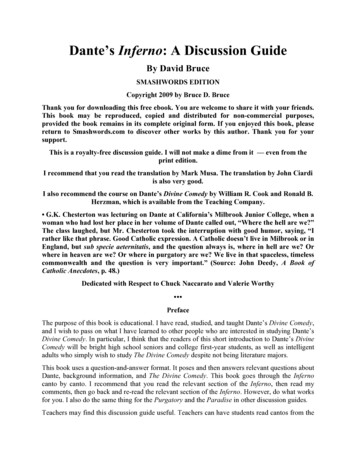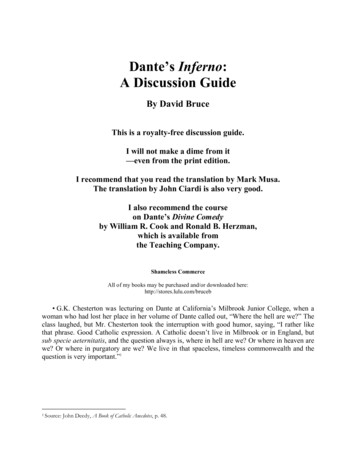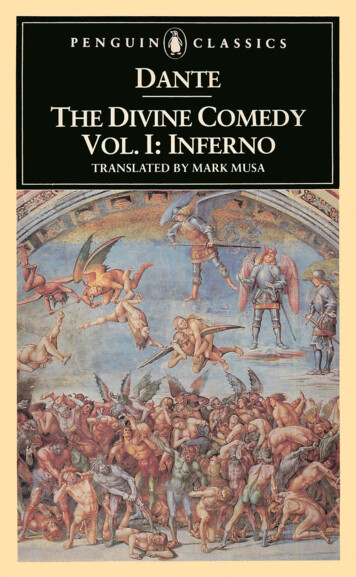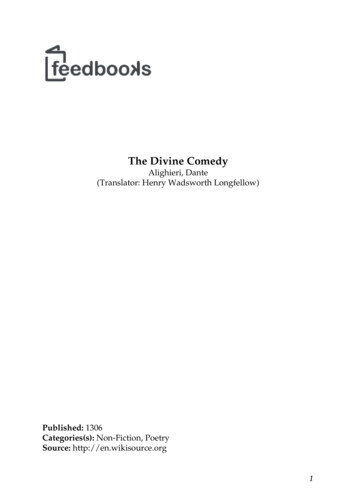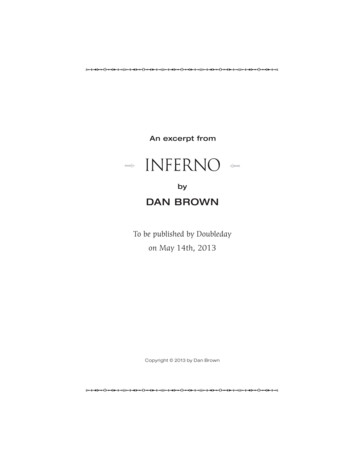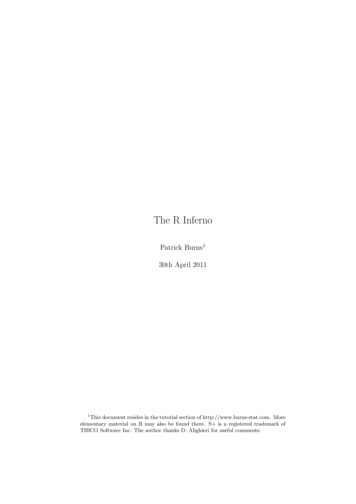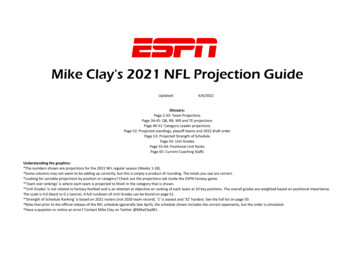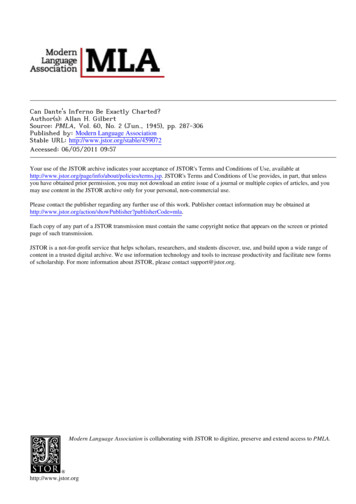
Transcription
Can Dante's Inferno Be Exactly Charted?Author(s): Allan H. GilbertSource: PMLA, Vol. 60, No. 2 (Jun., 1945), pp. 287-306Published by: Modern Language AssociationStable URL: http://www.jstor.org/stable/459072 .Accessed: 06/05/2011 09:57Your use of the JSTOR archive indicates your acceptance of JSTOR's Terms and Conditions of Use, available at ms.jsp. JSTOR's Terms and Conditions of Use provides, in part, that unlessyou have obtained prior permission, you may not download an entire issue of a journal or multiple copies of articles, and youmay use content in the JSTOR archive only for your personal, non-commercial use.Please contact the publisher regarding any further use of this work. Publisher contact information may be obtained at erCode mla. .Each copy of any part of a JSTOR transmission must contain the same copyright notice that appears on the screen or printedpage of such transmission.JSTOR is a not-for-profit service that helps scholars, researchers, and students discover, use, and build upon a wide range ofcontent in a trusted digital archive. We use information technology and tools to increase productivity and facilitate new formsof scholarship. For more information about JSTOR, please contact support@jstor.org.Modern Language Association is collaborating with JSTOR to digitize, preserve and extend access to PMLA.http://www.jstor.org
PMLAPVBLICATIONS OFTHE-MODERN-LANGVAGE-ASSOCIATION OF AMERICAIssued QuarterlyVOLUMELXJUNE, 1945.-4NUMBER 24-XXICAN DANTE'SBE EXACTLYINFERNOCHARTED?1. THE PROBLEM AND ITS ORIGINY his detailed account of his journey through Hell, Dante invitedclose attention from his readers. Factual-minded ones of a mathematical bias have become fascinated with the working out of the detailsas in a puzzle. In their zeal they have made diagrams to illustrate theirviews, such as appear in Giovanni Agnelli's Topo-Cronografiadel ViaggioDantesco. These and other charts have been widely circulated. For instance, Dinsmore's Aids to the Study of Dante gives those of Il DucaMichelangelo Caetani di Sermoneta.' Having seen such diagrams fromour earliest knowledge of Dante, we take them for granted as showinghis plan of the lower world. Even Croce, in La Poesia di Dante, admitssome use in making charts of the physical topography of the poem, onthe ground that "quella struttura Dante la voile ed esegui, ed esiste nelsuo libro" (p. 61). If it is in the book, it should be made clear. But whatif it is not?There is reason to think that much that passes for Dante's belongsto his commentators. For example, charts often show Jerusalem as directly above the center of the largest circle of Hell. Where does Dante saythis? There seems no doubt that he thought, as a matter of earthly geography, that Jerusalem was in the center of the hemisphere of land. Butthis is very different from the assertion that the Holy City is on the axisof his imaginary Inferno. To assert that, one must know the size of thatpoetical Hell. One cannot say with Professor Grandgent, in his wellknown edition, that its diameter "extends, apparently, from Italy tomid-Asia" (p. 4); there can be no such qualifications as apparently. If1 Thisvolume, though obviously intended for readers who do not use Italian, is mentioned with approval by Professor Grandgent in the bibliography of his edition of theComedy;it well deserves its nine printings totaling 3380 copies. It presumably has had cor-respondinginfluenceon Americanopinion.287
288Can Dante's Inferno Be Exactly Charted?Dante entered Hell at Lake Avernus, the diameter of the base of its conemust be twice the distance from Avernus to Jerusalem, but, as ProfessorGrandgent suggests, that diameter is not stated in the poem. It has beenin part derived from details in the poem, but has also behind it certainassumptions taken as adequate by chartmakers, though not laid downby Dante. Such assumptions are that the poet never forgot, never revisedwithout making all necessary alterations throughout the poem, neverindulged in figurative language when dealing with topography; hencethat the Comedyis minutely consistent, so that the slightest word bearingon the physical structure of Hell, Purgatory, and Paradise can be takenas absolute in relation to any other word in any part of the poem, however remote; moreover, it is assumed the poet always observed mathematical symmetry unless he specifically disclaimed it. So far as I haveseen, the charts commonly, if not always, require such assumptions inaddition to details furnished by Dante. If small things may be comparedwith great, these assumptions may be likened to those of the early Greeks,of whom Mr. Jaeger writes:Anaximander'sconceptionof the earth and the universeis a triumphof geometricalimagination.It is a visible symbol of the idea of proportion,which isdeeply rooted in the thought and life of archaicman. Anaximander'sworld isconstructedon severelymathematicalratios. . The universeis . a completespherewith the sun at its center.Not only the courseof the sun but the coursesof the stars and the moon are circular.The outermostcircle is that of the sun,whichis 27 times the diameterof the earth. [Otherinstancesfollow.]The samemathematicaltendencyunderlaythe constructionof the Ionianmapof the world. Herodotusmakes fun of the schematicstructureof the oldIonian maps of the world, which showed the earth as roundas if it had beenturnedon a lathe, and surroundedby the Ocean-which had neverbeen seen bymortal eyes, at least on the east and north. It is an apt jest at the passionforconstructingmaps of the earth accordingto a priori geometricalassumptions(Paideia, pp. 155-156).Dante's work does show signs of symmetry, such as the one hundredcantos, but at the same time he was writing a poem, and moreover apoem that is a dream, in which the normal laws of space and time do nothold. Except in a dream, how could he represent himself as gettingthrough the globe of the Earth, with a diameter, he thought, of 6500miles, in little more than a day?2 Given this initial improbability, whatneed we suppose factual? According to their temperaments and theoriesof poetry, critics will interpret the topography of the Inferno as more orless regular; one who believes Dante committed to symmetry will see it2 Thisinitial impossibilitywas observedby Blanc (Vernon,Readingson Inferno29.9,p. 459).
Allan H. Gilbert289where others will see none. Yet even if it be granted that the assumptionsjust referred to are to some extent subjective, the details to which theyare to be applied must be fairly evident. If the Inferno is to be thoughtexactly laid out, mathematical details presumably appear in its description.Geometry, in either details or assumptions, is not prominent in theearly commentators. Jacopo the son of the poet, Jacopo della Lana, theauthor of the Ottimo Commento, Boccaccio, Benvenuto da Imola, theAnonimo Fiorentino, all say only the most brief and obvious things onthe topography of the Inferno. If the poet himself had left a tradition ofa highly mathematical Inferno or if the age was deeply interested in it,would the commentators have neglected it altogether? While the silenceof Boccaccio and the rest does not prove that they knew of no such interpretation, it is more than a hint that in the fourteenth century the Inferno was not a geometrical problem for either Dante or his readers.The first appearance of the mathematical Inferno, so far as I know,is in the commentary of Landino, which appeared in 1471. Its descriptionof Hell is attributed by its author to Antonio Manetti. Manetti's ownwork, a Dialogo circa al sito, forma, et misure dello inferno di DanteAlighieri poeta excellentissimo,appeared after his death in 1506.3Perhapshis views changed after 1471; at any rate he makes some objection toLandino's description of Hell. He must, however, have been thinkingstill more of the earlier commentators when he declared that the studentof the structure of the Inferno must make use of arithmetic, geometry,and even astrology, and that he desires to bring to light the truth hiddenfor two hundred years. He would have been as dissatisfied with theartists as with the scholars.It seems likely that he knew the fresco by Nardo di Clone (formerlyattributed to Andrea Orcagna) in Santa Maria Novella, usually takenas painted with Dante in mind; indeed could a Florentine have done sucha thing without consciousness of Dante? Other representations of Hellmay be cited, as those of Fra Angelico at St. Marks, Francesco Traini inthe Campo Santo at Pisa,4 and Taddeo di Bartolo in the Collegiate3 This edition was published with the poem. The separate edition, of which I have usedtwo copies, has neither place nor date; it may be of about 1510.G. Milanesi, Operetteistorischedi A. Manetti, p. xvii, tells of a codex of the Divine Comedy(Magliabecchiana Ms. Pal. I 33), dated 1462, in Manetti s hand, which has some pen drawings to explain the architecture and fabric of the Inferno.Something on geometric explanations after Manetti is furnished by Giovanni Agnelli'sTopo-Cronografiadel Viaggio Dantesco (Milano, 1891), and by W. W. Vernon's Readingson the Inferno of Dante (London, 1906), I, xxxviii.4 Millard Meiss, "The Problem of Francesco Traini, The Art Bulletin, xv(1933), 127171. Bernhard Berenson, Pitture Italiene del Rinascimento, Milano, n.d., p. 499.
290Can Dante's Inferno Be Exactly Charted?Church at San Gimignano. These, all somewhat Dantesque,5 would havebeen unsatisfactory to Manetti as illustrations of the Inferno.Soon after the beginning of printing, then, a time when Manettithought that in Florence "everything was commonly known and inprint, though once books cost a fortune" (p. 4v), nothing satisfactory tohim on the structure of the Inferno was to be had. In other words, for acentury and a half after Dante no one had pointed out the mathematicalrelations Manetti believed in.It has been suggested to me that interest in the structure of the Infernois now waning, and indeed some commentators even in the last centurypaid little attention to it. Yet there are those who hold to it; it does receive attention in the teaching of Dante in our colleges. And indeed, ifthe charts tell the truth, a position at least as strong as that of Croceshould be maintained. If, however, the charts do not illustrate the poetry,teachers and readers cannot too soon reject them, with all other excessesof over-literal comment.2. ANALYSIS OF THE INFERNOAfter more than four centuries of Manetti's influence, a reader of theInferno cannot easily free himself from the assumptions of the geometricians. Yet every reader should wish to know what is actually given bythe poet, whether it be symmetry or asymmetry. Perhaps now the student can only ask continually: What interpretation is required in thispassage? must it be geometrical? may it be geometrical? is some otherinterpretation possible? is some other probable? necessary? Admittedly,to read with a non-geometrical hypothesis in mind may lead to unconventional results, even to those at the other extreme from excessivegeometry. But no mean is likely to be found unless both extremes arebefore us.In the following analysis I aim to mention all exact topographic indications supplied by Dante and to touch all passages where such noticeswould be welcome to chart-makers, even though nothing definite isactually given. What the poet himself says on structure is obviously to beaccepted.Every reader knows that the Inferno, as Boccaccio says, is a great pitdescending to the center of the earth, with terraces at various placeson the slope.6 Since the terraces form parts of circles that gird the abyss6 How Dantesqueis debatable.Perhaps,like the Inferno,they owe somethingto themosaicsof the Baptisteryin Florence.See ErnestH. Wilkins,"Dante and the Mosaicsofhis Bel San Giovanni,"Speculum,ii (1927),1-10.6 Comentoalla "DivinaCommedia"(Bari, 1918), e.g., Proemio,lect. 1 (vol. 1, p. 124);lect. 35 (vol. 3, pp. 8, 9). The genuinenessof the firstpassageis questioned.
Allan H. Gilbert291(4.24), the shape of Hell as a whole is that of an inverted cone with stepson its sides.Dante and Virgil pass into Hell through a gate in the mountain side(1.31, 61; 3.11). No indication is given of its place and there is no suggestion of descent as they enter. Ere long they see a great river (3.71),theAcheron, over which Charon takes them. This river is in a plain (3.130),apparently a spacious one. Dante next finds himself on the verge of thedeep valley (4.10) of Hell, and he and his companion descend to the FirstCircle. Walking not far (4.67) through the crowd of shades, they meetthe great poets, whom they accompany until they reach a castle encircledby seven walls and encompassed by a beautiful little stream; passingthrough seven gates they come to a meadow. Having seen the wise menof this world, they go by a different path to the descent to the Second Circle, smaller in circumference (5.2). In this Second Circle there is moreeffect of space than in the First; a great crowd are borne about by thehurricane or are flying like cranes. Dante falls fainting and when he recovers is in the Third Circle. Whether that is on a lower level we arenot told. The place has its own atmosphere, but otherwise there is nosuggestion of size. At the edge of the valley (6.112) is the descent to theFourth Circle.In spite of Pluto, the travelers make their way down the bank (7.17),7to find the avaricious and the prodigal engaged in what is called a ringdance or a dizzy dance. The sinners, pushing great stones before them,move around a circle until they meet; then they turn and move backaround their half circle until they meet again, to repeat the process.The numbers here are greater than elsewhere (in Hell?). It is to benoted that the word cerchio, that used commonly for the circles of theterraces, is applied to the paths in which the dance goes on. Does thisimply that the sinners go around the Fourth Circle of Hell, as Landinothinks?8 Obviously anything can happen in a dream, but if Dante hasany thought of consistency, the sinners must move many miles betweeneach meeting, and the Circle must be of breadth sufficient to accommodate the multitude who push their rocks. The smallest estimate I haveseen for the circumference of this circle is 440 miles; other estimates rise7 The wordlaccain 7. 16 is sometimesexplainedas ditch.The AnonimoFiorentinocallsattention to its meaningpart "della coscia da lato dell' animale,"and so "la costa delmonte"(Commentoalla "DivinaCommedia"d'anonimoFiorentinodelsecoloXIV [Bologna,1866],p. 188). It is temptingto call it haunch,as a figurefor the projectionon the side ofthe cone of Hell made by the circle.In any case laccaseems to be a synonymfor cerchiothat rimesproperly.8 Dante,conl'espositionidi ChristoforoLandino(Venetia,1576),p. 41, on Canto7.This is also the opinionof Jacopodella Lana (Commento[Bologna,1866],p. 171, onCanto7),
292Can Dante's Inferno Be Exactly Charted?into thousands. At the same time the circles of the dancers are smallenough to let Dante see the whole process; in other words this Circle forthe purposes of the poet must suddenly become smaller than the smallestof the bolge of Malebolge, lower down where the cone of Hell is muchdiminished (30.86). The alternative is that the whole Fourth Circle isnot used and that the word cerchio applies only to the circle or circlessuitable for dancers; then the plain would be thought of as covered by amultitude, all of whom are engaged in the dance, perhaps in many smallrings.9 If Dante does mean the whole Fourth Circle to come under ourview, this would seem to be the only instance of such an intention. Itmay be suggested that here and elsewhere in his dream Dante is giftedwith superhuman powers of vision; there seems, however, to be no evidence of it.Crossing this Circle, the poets pass near a fountain and descend theslope to the Fifth Circle, where is a marsh, the Styx, made by the waterspouring down from the fountain. Around this and at the foot of thebank, they make a circuit toward a distant tower. A boat appears, to takethe travelers across the marsh. While in the boat Dante hears a sound,which he learns is the wail of the great crowd in the city of Dis, of whichonly the tower has been visible because of the mist and the distance(8.5). As they draw nearer, the mosques of the city can be seen. Then,after a long circuit, passing deep ditches of fortification, they come to thegate, but are refused entrance. As they wait, Virgil explains that themarsh girdles the city around (9.32). Then an angel comes over theswamp and opens the gate without hindrance. The poets then enter, thuspassing from the Fifth to the Sixth Circle. Here, it must be observed, thetwo Circles are on a level, so that no descent is required.Within the wall Dante sees "ad ogni man grande campagna" (9.110),filled with sepulchres glowing with flames, where the citizens dwell intombs instead of houses. Between the tombs and the lofty city-walls withtheir galleries, as though in a space left vacant between wall and housesfor convenience in defence, the poets go to the right (9.132). This is thefirst reference to direction other than downward. After conversationswith sinners, they turn to the left and strike through the midst of the plainalong a path leading to a valley whence issues a terrible stench. The pathends on the verge of a bank formed by great rocks in a circle. Pausingthere, Virgil explains the remainder of the Inferno, contrasting the sinnersbelow them with those above them and outside the walls of the city ofDis. The city apparently includes within its round wall all the Inferno9 The comment of the Anonimo Fiorentino runs: "Vanno costoro a percuotersi per unocamino fatto a modo d'uno cerchio, a dimostrare che queste loro peni sieno eterni" (pp.184-185). Botticelli's drawing of this circle shows stones rolled in various directions.
Allan H. Gilbert293below it. Acheron is then a circular moat extending entirely around theSixth Circle, though our attention is fixed on the part Dante sees andnothing is actually said about the rest of the Circle; only one gate ofentrance is mentioned.10It is difficult to see any function for the wall ofthe city except as a boundary fence, since no sinner above can wish tocome into lower Hell and, as the action of the Angel who admits the poetsshows, the forces of Heaven cannot be kept out. Though in the SixthCircle itself the city is considered to include all the rest of Hell, it is notso spoken of later; its city-like function operates here alone, and theintention is a parody of a city on earth.When the poets come to the edge of the Sixth Circle they are obligedto go much farther before they can descend. The way down is more difficult and longer than any of the previous descents (11.1; 12.2, 28), indeedlike going down a mountain. While still on the slope, they look at theRiver of Blood bent into a bow to embrace all the plain, as a stream maybe seen from a high hill. A centaur guides them up the river, which continually becomes more shallow until they can cross where it is ankle-deep.He says that further still, at no great distance (12.130), it is again muchdeeper. What Dante presents here is the river flowing through a flat valleyand now shallow, now deep. He is interested in only as much of it as canbe viewed from the hill. The word arco (12.52) suggests, however, thesymmetrical encircling of all Hell below, if the linecome quellache tutto il piano abbraccia(12.53)refers to the remainder of the Circle or of the Inferno, and is not merely afigure from an earthly river. Here, as elsewhere in passages mentioningtheir curvature, the Circles must be imagined so small that the curve isplain to the eye, if Hell is geometrical. That hardly indicates a diameterof hundreds of miles. However that may be, there is no poetic reason whyDante cannot change the suggested size of Hell from line to line as suitshis purpose.From the bank of the river the travelers go into the pathless woodwhere harpies dwell. As they talk with one of the souls, two others comeup pursued by a great pack of dogs. At the edge of the wood is a plainof burning sand, around which the dolorous wood is a garland, as is theevil ditch for the wood. When taken with previous references to the circle,the word garland evidently relates to the complete circles made by Riverof Blood and forest. At the same time, this canto includes a passage thatboth reinforces the symmetrical interpretation and lessens it. Across thefiery plain passes a stream whose water, as coming fron Phlegeton above,10The singularand the pluralof porta,usedindifferently,seemsto referto but one opening throughthe walls,and but one tower,as for a gate, is alludedto.
294Can Dante's Inferno Be Exactly Charted?is red. Its waves subdue the flames so that its course gives a passage acrossthe burning sands. After he has been told that this stream descends fromthe upper world, Dante asks why it has not before been seen, and learnsthat even though, as they have been going downward, they have beenbearing far to the left, they have not completed a revolution around thecone of Hell,per che, se cosa n'appariscenuova,Non dee addurmaravigliaal tuo volto (14.128-9).If the Circles had been passed through at other points, other noveltiesmight have appeared.The plain is evidently extensive, since they go along the bank of thestream until they are out of sight of the wood and then enough fartherfor some hundred lines of converse; the noise of the waterfall becomesaudible; as they draw nearer it is so loud that if they had spoken theycould not have been heard. In spite of this, we are told of conversationbetween Dante and Virgil, and Dante and the usurers.Getting on Geryon's back, the two are carried down for a great butunspecified distance, like that on which a falcon descends through ahundred rings. Seemingly it is greater than the descent down the hill tothe plain of Phlegeton; at least Geryon makes it more impressive, but, ifone is to be factual, the monster may have been employed because of thesheerness of the cliff rather than its mere height. They go so far as to losesight of the circling wall of Malebolge; at least Dante says:vidi spentaOgni veduta fuor che della fera (17.113-4).A realist may speculate on whether Dante made out the plan of Malebolge from Geryon's back or whether he learned it later. At any rate, atthe bottom of the cliff, the landscape is a very large and deep pit; thespace between the cliff and the pit is divided into ten concentric valleysresembling the moats that encircle a well-fortified castle; just as suchmoats are crossed by bridges, so the valleys are bridged by crags orscogli which begin at the cliff. These bridges are not, however, drawbridges, but solid and high arched (18.111; 21.3, 108, etc.).Is there a single scoglio or line of bridges from the circumference to thecenter, or are there a number of such lines at intervals, like the spokes ofa wheel? If the central pit is like a city, it would have more than one entrance; if like a castle (castelli in 18.11 seems to mean castles) it probablywould have but one. Yet the comparison surely must not be pressed toohard. There is but one instance of scoglio in the plural (18.16); other cragscrossing the ditches are mentioned only by the lying devils (21.111, 125;23.140). The plural in 18.16 may be accounted for as referring to the
Allan H. Gilbert295nine bridges (one for each valley except the sixth), since ponte and arcoseem to be used interchangeably with scoglio. The early commentatorsseem to think of but a single line of bridges.1 The poem says that thescoglio where it leaves the cerchiaof Malebolge is higher than the embankment (18.70); after that the effect is of a series of bridges, each one leavingthe level of a bank, rising in the middle (18.102) to a colmo (19.128), andthen going down to the bank again. Yet it can hardly be proved thatwhenever Dante uses the word scoglio he does not have in mind the seriesrather than the single bridges; sasso (23.134) clearly refers to one seriesof bridges as a unit.The only instance that might be clear is amusingly ambiguous or evenmay be said to make against the notion that scoglio may mean one singlebridge of the series, as will now appear. There is some increase in thedifficulty of crossing the successive bridges. That over bolgia 4 is sconcioed erto(19.131), that over bolgia 5 is duro (21.43), that over bolgia 6 is lacking, that over bolgia 7 isronchioso,stretto e malagevole,Ed erto piu assai che quel di pria (24.62-3),and that over bolgia 8 is so difficult that the hand must aid the foot inclimbing to the summit of the bridge's arch (26.18). If Dante had thisseries in mind, quel in the quotation must refer to the bridge over bolgia5.12But according to the usual theory, the poets have shifted from one11This seems true of the OttimoCommento,which promisesa figure,unhappilynot inthe codex.The AnonimoFiorentinoalso contemplatesbut one scoglio:"Rendesimilitudine,comemolti fossi l'uno innanzi all' altro cingonouno castello, cosl quelli cerchietti, era l'unoinnanziall' altro, et come i ponticellisono soprai fossi per poterpassare,cosi uno scogliosi moveache attraversaqueglicerchiettiinfinoal pozzo;et in quellaschienadove questoscogliosi partedalla ripa,dice l'Auttorech'eglilascia Gerione"(Canto 18, pp. 405-406).This is confirmedby Canto21, pp. 466-467, and Canto23: "Ch'euno scoglioche ricideifossi et fa ponte dall' uno all' altrofosso, salvo che in questopresentee rotto, et giace permodoche, comeche malagevolmente,purepersu vi si pu6 ire" (p. 497).Benvenutoda Imola seems equallyclear: "Imaginareet finge tibi in mente tua unumcastellumrotundumin magna planitie campestri,quod habet circa se plures et pluresfossas,et juxtaportamcastellia ripainfimaincipituna volta pontis,quaecooperitprimamfossamusquead secundamripam;et ita secundavolta incipit a sectlndaripa, et cooperitsecundamfossamusquead tertiamripam;et ita de omnibususquead decem;ita quodsintdecemarcuscontiguisuccessiveunuspost alium,et tamensit totus unuspons rectus"(ComentumsuperDantis Comoediam[Florence,1887],on Canto 18, p. 3). Cf. also Canto 21,p. 117;Canto23, p. 184.12Is it possibleto suggestthat Dante originallyhad a bridgeover bolgia6 and revisedit out, but did not changethese succeedingreferences?Benvenutoda Imola makes queldi pria applyto bridge6, and explainsertoassai as meaningthat bridge7 "quieratinteger,erat altior."VernonacceptsScartazzini'sopinionthat the comparisonis betweentwo ofthe lines of bridges,or bridgeways,fromthe outerwall of Malebolgeto the seventhbolgia.
296Can Dante's Inferno Be Exactly Charted?series of bridges to another; according to such an interpretation, quelmust refer to the scoglio, in the sense of entire series of bridges,'3that thetravelers have left.There is one other difficulty. When the poets have crossed the tenthbolgia, they are said to have come to the last bank of the "lungo scoglio"(29.53). It is tempting to make this apply to the long way from thatpoint back to the encircling cliff of Malebolge, neglecting the break atbolgia 6. But if the poets have traveled on two scogli, the length will goback only to the sixth ditch. Or, another possibility, we later learn thatbolgia 10 is half a mile wide (30.87), a long bridge in Dante's time. Weresome of the earlier bolge narrower?The notion that there is a fixed number of scogli, or so many that wemust suppose that "they all converge, like the spokes of a wheel, uponthe pozzo, at the edge of which they stop,"'4 is connected with the wordraccogli (18.18), which seems to mean that the pozzo "gathers in" thescogli. This notion that an empty space "collects" crags was acceptableto Longfellow; to me it seems very odd. Something different is hinted byTorraca's note: "Raccogli: raccoglie, per la rima. Tronca i ponticelli ilpozzo, al quale vanno a finire tutti." Raccogli is a rime-word, perhapsone of those of which the writer of the OttimoCommentosaid:Io, scittore, udii dire a Dante che mai rima nol trasse a dire altro che quelloch'aveva in suo proponimento,ma ch'elli molte e spessevolte facea li vocabolidirenellesue rimealtroche quelloch'eranoappogli altri dicitoriusati di sprimere(Inferno10.85).So here he may be intending to say that the pozzo cuts off and ends the"lungo scoglio," or scogli, and not that it gathers them in.15The assumption of ten scogli appears first, so far as I know, in the commentary of Alessandro Vellutello, 1544 (Fig. 1). W. W. Vernon, acceptingthe number as ten, writes: "Blanc remarks that we have no intimationfrom Dante as to how many series of bridges there were, but from thenumber of fosses we may infer that there were ten" (Readings, Cantoponsgeneralis,Canto23, vol. 2, p. 184.ProfessorGrandgent'snote on 18.18.5 ProfessorGrandgent'snote endswith the words"at the edgeof whichthey stop."In his explanationof raccogliin this passageTommaseowrites: "ivi finisconil corsoloro"(Dizionario[Torino,1924],vol. 6, p. 13).Cf. the following:Sordelloed elli indietrosi raccolse(Purg.8.62).Quantunquedebilfrenoa mezzoil 1.1).Ovependeda selvaggerupiCavaspelonca,raccogliemmoi passi(Gerusal.Lib.8.41).Tommaseoin his Dizionarioexplainsthe last verb in the last passageas fermarli,arres13 Benvenutoda Imolacalls it14tarli.
CIM OOTTA v(FIG. 1. The Bridges of Malebolge, according to Vellutello, from Dante, con 'espositionidi ChristoforoLandino, et d'Alessandro Vellutello (Venice, 1578).IFIG. 2. Malebolge, from AntonioManetti's Dialogo circa al sito, forma, emisure dello inferno di Dante Alighieri(Firenze, c. 1510), p. 52v.FIG . . The City of Dis. Botticelli's drawing for Inferno 9.
FIG. 4. Geryon's Descent. Botticelli'sdrawing for Inferno 17.FiG. 5. The City of Dis, fromManetti, op. cit., p. 52r.FIG. 6. The Ci
May 05, 2011 · our earliest knowledge of Dante, we take them for granted as showing his plan of the lower world. Even Croce, in La Poesia di Dante, admits some use in making charts of the physical topography of the poem, on the ground that "quella struttura Dante la voile ed esegui, ed esiste nel suo libro" (p. 61). If it
